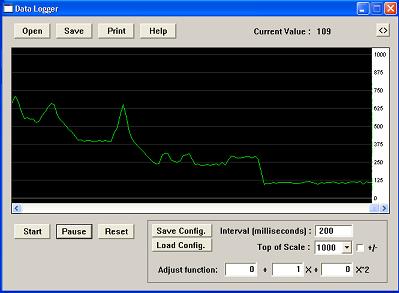
Tacho - 27-5-2008 at 04:37
Having moved to an apartment and not being able to bring along my beloved paraphernalia, my contributions to this forum became very limited. Besides,
we have been lucky to have so many new contributors with a high level of knowledge that I rarely feel that I can add anything new to threads. But here
I post a link to a free open source datalogger. It seems like something a lot of people here could use. Its written in Emergence Basic, a really
good, powerful and compact freeware compiler, with a nice IDE and debugger , excellent for making small lab applications.
The source code: http://www.ionicwind.com/forums/index.php/topic,2482.0.html
The free compiler: http://www.ionicwind.com/
Tacho - 11-6-2008 at 13:54
Attached is a distribution zip file with a new improved version.
Attachment: Datalogger.zip (95kB)
This file has been downloaded 858 times
Tacho - 11-6-2008 at 13:56
A screenshot:

Magpie - 11-6-2008 at 18:51
Now I wish I hadn't destroyed my old PC. Maybe I could have made an oscilloscope out of it. Do you know, Tacho?
Edit: I feel very sorry for you (and BromicAcid) for having to give up your beloved paraphenalia. You both must feel like fish out of water. I hope
that some day soon you will both be able to get back to the high level of experimentation that you previously reported on this forum.
[Edited on 11-6-2008 by Magpie]
Tacho - 12-6-2008 at 03:45
Thank you for your sympathy, Magpie.
This datalogger is a bit too slow for watching waveforms, but there are a few freeware oscilloscopes for pc on the web. My favorite is Winscope ( http://www.mitedu.freeserve.co.uk/Prac/winscope.htm ) . However, you are limited to the audio frequencies (up to about 20khz). I suggest you also
download a great freeware signal generator, SigJenny: http://www.natch.co.uk/downloads/SigJenny/SigJenny.html
If you use external signal sources, don't forget to protect your sound card by using (at least) opposite diodes as described in the Datalogger help
file. You are right, when using external signals there is always risk to the sound card. An old computer comes in handy unless you are totally sure
about the levels of your signal.
Back to chemistry: I have two uses for this datalogger in the future: One is to use it in some sort of chromatograph for the amateur, easy to build
and easy to use. The other is to measure thermal conductivity of a series of resins+fillers in order to find the best mixture to dissipate heat. This
has good uses in electronics.
